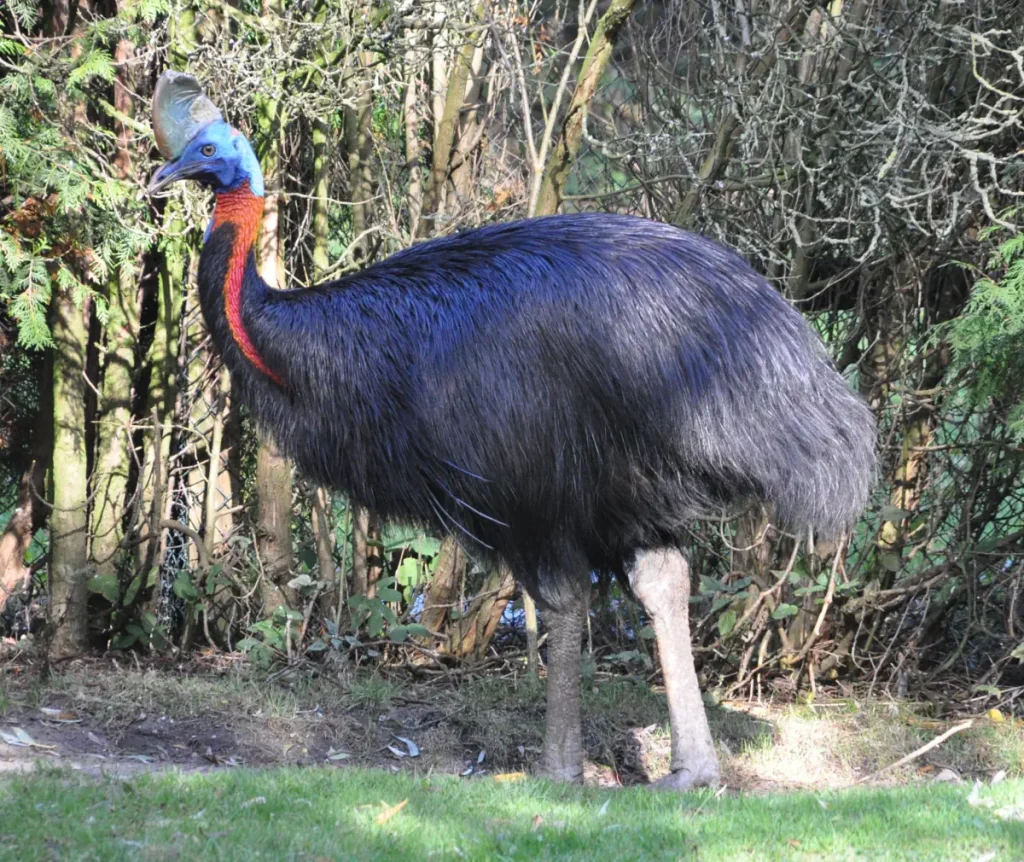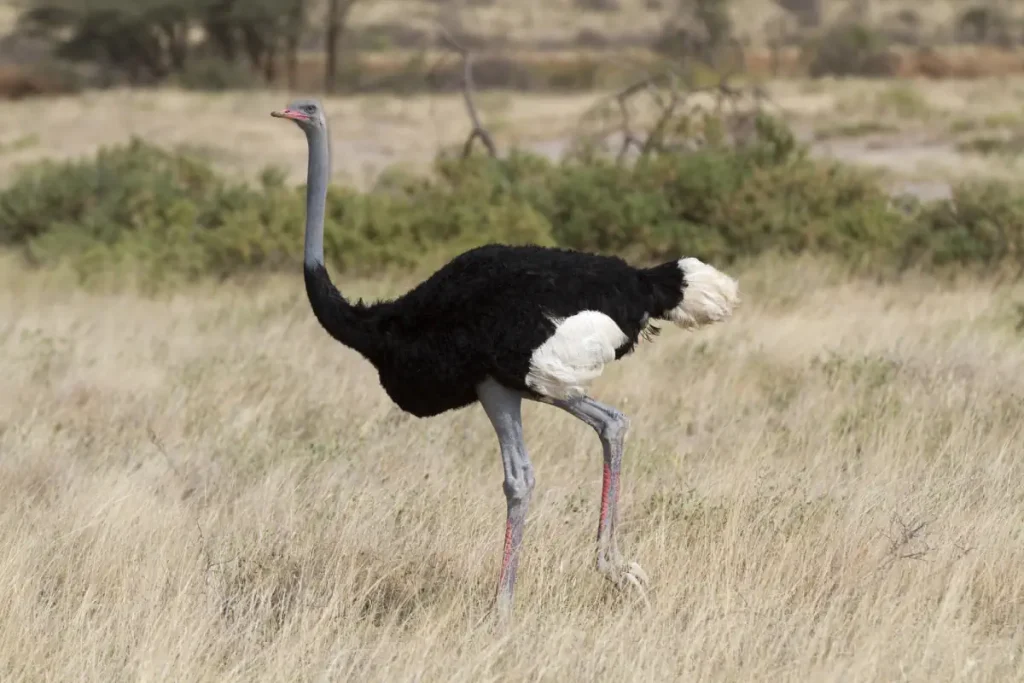Birds come in a remarkable range of sizes, with species varying dramatically in size from the tiny bee hummingbird to the towering ostrich. This incredible diversity in bird size allows different species to adapt to various ecological niches, enhancing their chances of survival in changing environments. Here are the 15 largest birds in the world (the largest living bird species).
15. Dalmatian pelican (up to 15 kg / 33 lb)

The Dalmatian pelican (Pelecanus crispus) is among the world’s heaviest flying bird species. It measures 160 to 183 cm (5 feet 3 inches to 6 feet 0 inches) in length, 7.25-15 kg (16.0-33.1 lb) in weight, and 290-345 cm (9 ft 6 in-11 ft 4 in) in wingspan. It breeds in Eurasia, from southeastern Europe to India and China.
14. Andean condor (up to 15 kg / 33 lb)

Andean condor (Vultur gryphus) can reach a weight of 11 to 15 kg (24 to 33 lb) for males and 8 to 11 kg (18 to 24 lb) for females. Overall length can range from 100 to 130 cm (3 feet 3 inches to 4 feet 3 inches).
The Andean Condor also has a very large wingspan, up to 3.3 meters (10 feet 10 inches), exceeded only by the wingspans of four seabirds and water birds (the wandering albatross, southern royal albatross, great white pelican, and the Dalmatian pelican).
Andean condor plays an important role in the folklore and mythology of the South American Andean regions. It is a national symbol of Argentina, Bolivia, Chile, Colombia, Ecuador, Peru, and the Venezuelan Andes states. It is the national bird of Bolivia, Chile, Colombia, and Ecuador.
13. Trumpeter swan (up to 17.2 kg / 38 lb)

Trumpeter swan (Cygnus buccinator, from the Latin Cygnus -swan- and buccinare -to trumpet-) is one of the largest and heaviest flying bird species in the world. They are native to North America and are the heaviest birds living there. The trumpeter swan is named for its sonorous calls.
The trumpeter swan also has a very large wingspan, which can exceed 3 meters (10 feet). The largest known male trumpeter attained a length of 183 cm (6 ft 0 in), a wingspan of 3.1 meters (10 feet 2 inches), and a weight of 17.2 kg (38 lb).
At one point in history, the trumpeter swan was dragged to near extinction: in the 19th and early 20th centuries, they were hunted heavily. By 1933, fewer than 70 wild trumpeters were known to exist in remote hot springs in or near Yellowstone National Park, and the extinction seemed inevitable.
But during an aerial survey of Alaska’s Copper River in the 1950s, several thousand trumpeter swans were discovered. This population provided critical genetic stock and with careful reintroductions by wildlife agencies, the trumpeter swan population gradually increased to over 46,000 birds by 2010.
12. Great bustard and Kori bustard (up to 18 kg / 40 lb), the heaviest living flying animal in the world

The Great bustard (Otis tarda) and Kori bustard are probably the heaviest living flying animal. The Great bustard can be seen in central/south Europa and temperate Asia. But Portugal and Spain now contain about 60% of the world’s Great bustard population.
A male Great bustard is typically 90-105 cm (2 ft 11 in-3 ft 5 in) tall, with a length of around 115 cm (3 ft 9 in), and has a 2.1-2.7 meters (6 feet 11 inches-8 feet 10 inches) wingspan.
The males can range in weight from 5.8 to 18 kg (13 to 40 lb). Females are much smaller, weighing from 3.1 to 8 kg (6.8 to 17.6 lb).
The Kori bustard (Ardeotis kori) is native to Africa. The male kori bustard is 120 to 150 cm (3 feet 11
They may have a wingspan of about 230 to 275 cm (7 feet 7
Females
11. King penguin (up to 18+ kg / 40+ lb)

King penguins breed on the subantarctic islands in the northern reaches of Antarctica, South Georgia, and other temperate islands of the region.
The average weight of the King penguin (Aptenodytes patagonicus) is similar to or just slightly higher than that of the largest living flying birds – the Great bustard and the Kori bustard.
They stand 70 to 100 cm (28 to 39 inches) tall and weigh from 9.3 to 18 kg (21 to 40 lb). Males are slightly larger than females. It is the second-largest species of penguin (the largest is the Emperor penguin).
10. Dwarf cassowary (up to 26 kg / 57 lb)

Dwarf cassowary (Casuarius bennetti) is between 99 and 150 cm (3.25 and 4.92 ft) long and weighs between 17.6 and 26 kg (39 and 57 lb).
It is distributed throughout the mountain forests of New Guinea, New Britain, and Yapen Island, at elevations up to 3,300 meters (10,800 feet).
9. Darwin’s rhea (up to 28.6 kg / 63 lb)

Darwin’s rhea (Rhea pennata), also known as the lesser rhea stands at 90 to 100 cm (35-39 inches) tall. Their length is 92 to 100 cm (36-39 inches) and their weight is 15 to 28.6 kg (33-63 lb).
They can be found in the Altiplano (Spanish for “high plain”, the name of Andean Plateau or Bolivian Plateau, in west-central South America, where the Andes are at their widest) and Patagonia in South America.
8. Domesticated Turkey (up to 39 kg / 86 lb)

The domesticated turkey (Meleagris gallopavo) was probably domesticated in central Mesoamerica at least 2,000 years ago. The English name, “turkey” is the result of an early misidentification of the bird with an unrelated species which was imported to Europe through the country of Turkey.
They can grow up to 39 kg (86 lbs).
7. Greater rhea (up to 40 kg / 88 lb)

Weighing 20-40 kilograms (44-88 lb), the greater rhea (Rhea americana) is the largest bird on the American continent. Their strong powerful legs allow them to run up to 35 mph (56 km/h).
They usually stand about 1.5 meters (4 feet 11 inches) tall.
The greater rhea is endemic to Argentina, Bolivia, Brazil, Paraguay, and Uruguay.
6. Emperor penguin (up to 45 kg / 99 lb)

The emperor penguin (Aptenodytes forsteri) is endemic to Antarctica. Reaching 130 cm (51 in) in height and weighing from 22 to 45 kg (49 to 99 lb), it is the tallest and heaviest of all living penguin species. The male and female emperor penguins are similar in plumage and size.
5. Emu (up to 60 kg / 99 lb)

The emu (Dromaius novaehollandiae) is the second-largest living bird by height (the largest one is Emu’s close relative, the ostrich): they can reach up to 1.9 meters (6.2 feet).
Emus weigh between 18 and 60 kg (40 and 132 lb). Females are slightly larger than males. They can sprint at speeds of 48 km/h (30 mph).
Today, the Emu is endemic to Australia. The Tasmanian emu and King Island emu subspecies became extinct after the European settlement of Australia in 1788.
4. Northern cassowary (up to 70 kg / 154 lb)

The Northern cassowary (Casuarius unappendiculatus), also known as the single-wattled cassowary is a large, bulky bird native to northern New Guinea. Females can weigh up to 70 kg (154 lb), with an average weight of 58 kg (128 lb). Males are smaller.
Northern cassowaries measure up to 149 cm (4.89 feet) long and stand 1.5-1.8 m (4.9-5.9 feet) in height.
Despite its stocky build, a Northern cassowary can sprint up to 50 kilometers per hour (31 miles per hour).
3. Southern cassowary (up to 83 kg / 183 lb)

The southern cassowary (Casuarius casuarius), also known as double-wattled cassowary or the Australian cassowary is distributed in tropical rainforests of Indonesia, New Guinea, and northeastern Australia, and it prefers elevations below 1,100 meters (3,600 feet) in Australia and 500 meters (1,600 feet) in New Guinea.
In general, this giant bird ranges from 127 to 170 cm tall (50-67 inches) and weighs around 36 to 50 kg (males) and 68 kg (females). The maximum size recorded was 190 cm (75 inches) tall and 83 kg (183 lb) weight.
The southern cassowary is the largest extant Asian bird (since the extinction of the Arabian ostrich, and previously the moa of New Zealand) and the largest extant Australian bird (though the emu may be slightly taller).
2. Somali ostrich (up to 130 kg / 287 lb)

The second-largest living bird on Earth, the Somali ostrich (Struthio molybdophanes) is a large flightless bird native to the Horn of Africa, especially in north-eastern Ethiopia and across all of Somalia.
It was previously considered a subspecies of the common ostrich but was identified as a distinct species in 2014.
A male Somali ostrich can weigh up to 130 kg / 287 lb.
Males range from 6.9 to 9 feet (2.1 to 2.7 meters) in height
1. Ostrich (up to 156.8 kg / 346 lb) – the biggest living bird in the world

The ostrich or common ostrich (Struthio camelus) is the largest bird on Earth. It is native to Africa. They usually weigh from 63 to 145 kilograms (139-320 lb), or as much as two adult humans. Exceptional male ostriches can weigh up to 156.8 kg (346 lb).
Male ostriches can be from 2.1 to 2.8 meters (6 feet 11 inches to 9 feet 2 inches) in height, while female ostriches range from 1.7 to 2.0 meters (5 feet 7 inches to 6 feet 7 inches) tall.
Ostriches have large, powerful legs. Although its bulky body means that flying is out of the question, the ostrich has adapted to life on the ground with impressive agility.
Ostriches are also superb runners that can sprint at speeds of up to 70 km/h (43 mph). This also makes the ostrich the fastest animal on two legs.
The ostrich is also an endurance runner and can jog at 30 mph (48 km/h) for as long as half an hour.
They can also cover 3 to 5 meters (9.8 to 16.4 feet) in a single stride.

Largest birds in the world: the honorable mentions
Wandering albatross

Measuring from 2.51 to 3.7 meters (8 feet 3 inches to 12 feet 2 inches), the Wandering albatross (Diomedea exulans) has the largest wingspan of any bird.
Measuring from 2.51 to 3.7 meters (8 feet 3 inches to 12 feet 2 inches), the Wandering albatross (Diomedea exulans) has the largest wingspan of any bird.
The wandering albatross is also one of the most far-ranging birds. Some individual wandering albatrosses are known to circumnavigate the Southern Ocean three times (covering more than 120,000 km or 75,000 miles) in one year.
The IUCN (International Union for Conservation of Nature) lists the wandering albatross as vulnerable status.
The largest bird of prey: The Philippine Eagle

The Philippine Eagle (Pithecophaga jefferyi) is considered the largest of the extant eagles in the world in terms of length and wing surface. It is typically reported as measuring 86-102 cm (2 feet 10 inches-3 feet 4 inches) in total length.
The Philippine eagle also has a wingspan of 184 to 220 cm (6 feet to 7 feet 3 inches).
But, in terms of weight and bulk, Steller’s sea eagle (Haliaeetus pelagicus), the Harpy eagle (Harpia harpyja), and the Martial eagle (Polemaetus bellicosus) are bigger than the Philippine eagle.
Harpy eagles can weigh up to 20 pounds (9 kg).

Among condors, which are also considered birds of prey though they are primarily scavengers, the title goes to the Andean condor.
The Largest Bird Ever Lived on Earth: Vorombe titan
Until recently, the Aepyornis
Vorombe is one of three genera of elephant birds. Back in 1894, British scientist Charles William Andrews (30 October 1866 – 25 May 1924) described Aepyornis titan, the extinct “Elephant Bird” of Madagascar.

But, in
Their largest femur (MNHN MAD 368) measured by Hansford and Turvey could not be formally assigned to a cluster (group) as it was incomplete. The specimen is thought to belong to

Largest prehistoric birds
The largest known birds of all time might have been the elephant birds of Madagascar. The Australian Dromornis stirtoni was almost the same size. Both were about 3 meters (9.8 feet) tall and they shared the same estimated upper weight, around 500 kg (1,100 lb). Elephant birds were still extant as close as the 17th century.
The tallest bird ever was the giant moa (Dinornis maximus) at 3.6 meters (12 feet) tall.
The largest known flight-capable bird was Pelagornis sandersi, discovered in 1983 in Charleston, South Carolina, during construction for a new airport terminal. It lived 50 million years ago. The largest specimen found in Antarctica, and its wings, fully extended, spanned more than 6.4 meters (21 feet).
Pelagornis sandersi probably weighed between 48.5 and 88 lb (22 and 40 kilograms).
The heaviest known flying bird ever lived
The heaviest known flying bird ever lived, Argentavis magnificens (“magnificent Argentine bird”, or more literally “magnificent silver bird”), was more than twice Pelagornis’ weight but had a shorter wingspan. It had an estimated wingspan of 5.09-6.07 m (16.7-19.9 ft), a height of circa 1.5-2 m (4.9-6.6 ft), and a mass of approximately 70-72 kg (154-159 lb).

The largest flying animals ever lived on Earth
The largest known flying animals overall are not birds, but instead the azhdarchid pterosaurs of the Cretaceous (the geologic period and system that spans 79 million years from the end of the Jurassic Period 145 million years ago – mya to the beginning of the Paleogene Period 66 mya).
The wingspans of larger azhdarchids, such as Quetzalcoatlus and Hatzegopteryx, have been estimated to exceed 10 meters (33 feet), with less conservative estimates being 12 meters (39 feet) or more. Mass estimates for these azhdarchids are on the order of 200-250 kg (440-550 lb).
Pterosaurs are often mistakenly thought of as dinosaurs. Unlike birds, which are avian dinosaurs, pterosaurs were actually flying reptiles.
Quetzalcoatlus: the largest flying animal ever lived on Earth (by wingspan)

Quetzalcoatlus
Its name comes from the Mesoamerican feathered serpent god, Quetzalcoatl.
Recent estimates based on greater knowledge of azhdarchid proportions place its wingspan at 10-11 meters (33-36 feet). Based on its wingspan, its height would have been at least 3 meters (10 feet).
Older studies give extremely low weight estimates for Quetzalcoatlus, which was as low as 70 kilograms (150 lb) for a 10-meter (32-foot-10-inch) individual. A majority of estimates published since the 2000s have been higher, around 200-250 kilograms (440-550 lb).

Birds are “avian dinosaurs”
Birds are from one of six basic animal groups, with the others being amphibians, fish, invertebrates, mammals, and reptiles. They are endothermic vertebrates, characterized by feathers, toothless beaked jaws, a high metabolic rate, a four-chambered heart, and a lightweight but strong skeleton.
Birds reproduce by laying hard-shelled eggs (eggs fertilize inside the female). The fossil record indicates that birds are the last surviving group of dinosaurs. So, they are also termed avian dinosaurs.
Ask a paleontologist who is familiar with the phylogeny of vertebrates and they will probably tell you that birds (avians) are dinosaurs. Using proper terminology, birds are avian dinosaurs; while other dinosaurs are non-avian dinosaurs, and, strange as it may sound, birds are technically considered reptiles.
Evolutionary Insights into Bird Size Variations
Birds exhibit an astonishing range of sizes, from the minuscule bee hummingbird to the imposing ostrich, showcasing the vast diversity within the avian world. This variation in bird size not only highlights their adaptability to different ecological niches but also enhances their survival prospects in changing environments. For example, smaller species can maneuver adeptly through dense foliage, while larger birds often traverse expansive distances and utilize a variety of food sources.
The diversity of bird sizes plays a vital role in their mating and nesting behaviors, influencing territory establishment and mate selection. Researchers focus on the evolutionary adaptations tied to bird size, investigating how these variations impact flight dynamics and habitat preferences. Ultimately, the wide range of bird sizes reflects the resilience and adaptability of avian species, enabling them to thrive in diverse habitats around the world.
Sources
- Bird on Wikipedia
- “Biggest Bird Confusion Over. It’s
Vorombe Titan Of Madagascar, Says Study” on NDTV - Trumpeted swan on
Wikipedia - Dalmatian pelican on
Wikipedia - Andean condor on
Wikipedia - Great bustard on
Wikipedia - Kori bustard on
Wiki pedia - King penguin on
Wikipedia - Dwarf cassowary on
Wikipedia - Darwin’s rhea on
Wikipedia - Domesticated turkey on
Wikipedia - Greater rhea on Wikipedia.com
- Greater rhea on woburnsafari.co.uk
- Emperor penguin on
Wikipedia - Emu on
Wikipedia - Northern cassowary on
Wikipedia - Southern cassowary on
Wikipedia - Somali ostrich on
Wikipedia - Ostrich on
Wikipedia - Wandering albatross on
Wikipedia - Philippine eagle on
Wikipedia - A giant prehistoric bird fossil with the
largest wingspan ever recorded was found in Antarctica on telegraph.co.uk - Argentavis on
Wikipedia - Quetzalcoatlus on
Wikipedia - “It’s official: researchers name Vorombe titan the world’s largest bird” on Digit.in
Vorombe on Wikipedia- “Are Birds Really Dinosaurs?” on ucmp.berkeley.edu
- “Vorombe titan: Researchers Name World’s Largest Ever Bird” on the Science News website
- Moon Landings: All-Time List [1966-2025] - February 2, 2025
- What Is Max-Q and Why Is It Important During Rocket Launches? - January 16, 2025
- Top 10 Tallest Rockets Ever Launched [2025 Update] - January 16, 2025

One reply on “15 Largest Birds in the World [With Photos]”
Seriously, Never realised penguins were so big. I was in a perception that they are small birds until I read your article. Thank you!